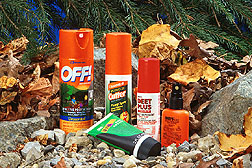Beating Summertime Insect Woes
|
|
Today, thanks to ARS research, consumers have some protection against mosquitoes.
Since World War II, ARS research has focused mainly on two types of mosquito protection for military personnel and the general public: treated fabrics and insect repellents for use on skin. In the mid-1950s, ARS researchers discovered the mosquito victim's dream: DEET, now a widely used repellent. Today, millions of people worldwide apply DEET to their skin; it's the main active ingredient in about 200 commercial products.
However, "DEET is very oily and has an unpleasant smell," says Donald R. Barnard, head of ARS' Mosquito and Fly Research Unit at Gainesville, Florida.
"Currently, there is no alternative as effective as DEET with the qualities that would be pleasing to consumers."
Finding such an alternative has been a primary goal of ARS scientists at Gainesville, where researchers have tested 16,000 new candidate repellents in the last 20 years—with several new ones in store for the future. One group of synthetic repellents under testing now, called piperdines, appears very promising as a possible DEET alternative.
ARS scientists, in cooperation with the U.S. Army, developed fabric treated with the insecticide permethrin for use in clothing that can be used as a barrier to prevent insects from biting U.S. troops who travel abroad. In many underdeveloped countries, tropical diseases transmitted by mosquitos are a problem—particularly malaria and dengue fever.
World Health Organization statistics report about 4 million malaria cases each year and about 1 million deaths, while about 24,000 deaths occur each year from dengue-related illnesses. About 2.5 billion people are currently at risk worldwide for dengue, and the potential for exposure to mosquito-transmitted diseases could increase if temperatures increase worldwide.
Today, the U.S. Department of Defense uses a two-pronged strategy: DEET and permethrin-treated clothing—called the personal protection system—against mosquitos and other health-threatening pests that could lead to possible disease exposure.
So what is in store for the next millennium? ARS researchers are looking at what makes us so tempting and tasty. They are trying to identify and understand what scents humans and animals emit that say to mosquitos, "Hey, free lunch!" They hope to take this knowledge and use it to develop new attractants, which could be used for monitoring or in combination with toxic baits to kill the pests.
"Ultimately, in the next millennium, we're trying to develop nonpesticidal control methods, which include biological, behavioral, biochemical, and genetic control technologies," says Barnard.—By Tara Weaver-Missick, Agricultural Research Service Information Staff.
This research is part of Arthropod Pests of Animals and Humans, an ARS National Program (#104) described on the World Wide Web at http://www.nps.ars.usda.gov/programs/appvs.htm.
Donald R. Barnard is in the USDA-ARS Mosquito and Fly Research Unit, Center for Medical, Agricultural, and Veterinary Entomology, 1700 S.W. 23rd Dr., Gainesville, FL; phone (352) 374-5931, fax (352) 374-5922.
"Beating Summertime Insect Woes" was published in the December 1999 issue of Agricultural Research magazine.







